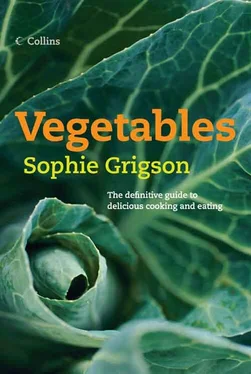Phil Vickery’s oil-braised salsify
This is how the chef Phil Vickery likes to cook salsify, braised gently to a tender richness in olive oil, then fried until the exterior is browned just before serving. It’s a distinctly restaurant technique (most of the cooking achieved in advance, requiring only a couple of minutes to finish), but one that adapts well to a home kitchen, especially when you are cooking for a dinner party and want to minimise last-minute kitchen shenanigans.
When Phil and I were talking vegetables, he also mentioned that this method works brilliantly with swede.
salsify
olive oil to cover
salt
Preheat the oven to 140°C/275°F/Gas 1. Scrub and peel the salsify. Cut into 10cm (4in) lengths. Place in an ovenproof dish that will take them in a close-fitting single layer – don’t use a dish that is way too big, or you’ll have to use way more oil.
Pour over enough oil to just cover the salsify. Slide into the oven and leave to braise gently for around 1 hour until tender. Leave to cool in the oil.
Just before serving, heat up a frying pan. Take the salsify out of the oil, drain well and fry briskly until browned here and there. Season with salt and serve immediately.
Salsify and flageolet salad
Salsify makes a fine salad all on its own, but I prefer it matched with other ingredients. Nothing too bold and intense, you understand. Pale green flageolets (if you use dried ones, soak 200g/7oz overnight, then simmer in unsalted water until tender; drain and dress while still hot), a few extra slender strips of grilled pepper, the sweet, tender leaves of a little gem lettuce. That’s much more like it. Try adding the thinnest slivers of Moroccan preserved lemon – delicatessens and some supermarkets sell them, but avoid the lemons preserved with chilli, which are too feisty for this. You will need just half of a normal-sized lemon, or an entire one if they are miniature lemons.
Serves 6
450–500g (1 lb-1 lb 2oz) salsify
2 tinned piquillo peppers, or 1 grilled and skinned red pepper, deseeded
1/2-1 preserved lemon (optional – see intro)
1 × 400g can cooked flageolet beans, drained and rinsed
1 tablespoon chopped parsley
leaves of 1 little gem lettuce
Dressing
1 tablespoon white wine vinegar
1/2 teaspoon Dijon mustard
a pinch of caster sugar
3–4 tablespoons extra virgin olive oil
salt and pepper
Scrub and peel the salsify, then cut into 5 cm (2 in) lengths and simmer in salted water until tender, but not mushy. Drain thoroughly.
While they are cooking, make the dressing in the usual way. In other words, whisk the vinegar with the mustard, sugar, salt and pepper, then whisk in the oil a spoonful at a time. Taste and adjust the seasoning – it should be fairly sharp to balance the starchiness of the flageolets, and lift the delicate salsify.
As soon as the salsify is drained, but while it is still hot, toss in a little of the dressing and leave to cool down. Cut the pepper(s) into very thin strips. Scrape the inner flesh out of the preserved lemon, if using, and discard. Cut the peel into extremely thin strips and mix with the salsify, peppers, flageolets and parsley, adding the remaining dressing. Set aside. Just before serving toss in the little gem leaves. Serve at once.
This is a classic French way of dressing up any number of vegetables, but it seems particularly well suited to salsify. They embrace the cream with consummate ease, and the warm aniseed scent of the tarragon brings out the best in them. Very good served with a plain roast chicken.
Serves 4–6
600g (1 lb 5oz) salsify
15g (1/2 oz) unsalted butter
2 tablespoons dry vermouth
4 tablespoons crème fraîche
leaves from 1 sprig tarragon, chopped
salt
Scrub and peel the salsify, then cut into 10cm (4in) lengths and simmer in salted water until tender, but not mushy. Drain thoroughly. Melt the butter in a frying pan and when it is foaming add the salsify. Fry for 2–3 minutes until beginning to colour, then add the vermouth. Swirl around and bubble until it is virtually all evaporated. Now add the cream, tarragon and salt and let it all cook down for a few more minutes until the sauce has thickened enough to just coat the salsify lightly. Taste and adjust seasoning, then serve.
As for salsifis à l’estragon, but replace the tarragon with a teaspoon (or two) of good curry paste – a soft korma paste is ideal. The idea is to give a mild hint of curry flavour, but not so much that it overwhelms the flavour of the salsify.
Swede is an unattractive vegetable. Lumpish, large and arrayed in dull colours, it does little to endear itself to a potential buyer. Beauty, we are told, lies beneath the skin and somewhat reluctantly I have now come to the conclusion that there is a dash of truth to this here. In the case of swede, it is not a startling beauty, but rather a quiet comforting comeliness.
It took a minor spot of focus-grouping amongst friends (thank you, Jess, Jennine et al) to draw me to this conclusion, having successfully ignored the swede for several decades. Now, I realise that, if it is cooked congenially and adequately buttered up (literally), lowly swede is actually rather good. And cheap. Not a bad thing, either. As a new convert, I even found myself defending it when a young friend of my son described it as the vegetable from hell. Which it can be when tarnished with age and presented watery and dull. Such is the stuff of criminal cooking, probably institutional.
Swede-novice that I am, the recipes I’ve chosen for this section are basic and straightforward. I’ve not yet got to the stage where I get inventive with swede, and besides I’m not entirely sure that it would be a good idea. There’s an underlying whiff of sulphur even in the freshest cannonball swede and it needs to be handled cautiously. Instead of treading roads previously unexplored, I’m playing safe, looking north to Scotland, where swedes are known as turnips or ‘neeps’, and south to Cornwall. And should you ever come across references to ‘rutabaga’ in American cookbooks, I hope you won’t be too disappointed to be told that this, too, is swede.
Swede keeps very well without rotting, but I would suggest that you do not attempt to mature your swedes for any length of time. Age brings out the sulphur bitterness, which stops being pleasant the second it is clearly detectable. So, pick out healthy-looking, firm and smooth-skinned spheres and cook them within a week at most.
The ideal storage place, as for most vegetables, is a cool, dry, airy spot, but failing that, the fridge will do nicely. A half-used swede should be covered in clingfilm before returning to the fridge and then used up within a day or two, before it starts tainting milk and butter.
Boilingand mashingtend to be the preferred methods of cooking swede. Together they work fine, but if there’s one thing to be avoided it is serving great big lumps of watery swede all on their own. The only times whole chunks of simmered swede are even remotely acceptable are when they’ve been cooked in a flavourful broth (as in Scotch broth) or beef stew. Swede is too doughty for more delicate chicken stews. Friends recommend roastingwedges of swede, or braisingwedges in olive oil (as for Phil Vickery’s salsify on page 83), but these are cooking methods for the swede aficionado, not for nervous beginners like me.
Читать дальше












